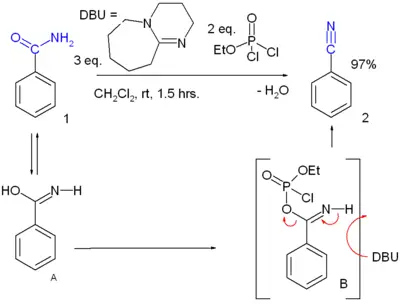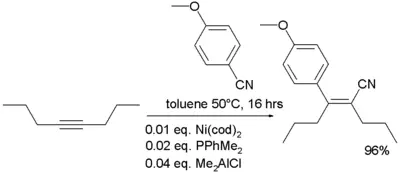Nitrile
A nitrile is any organic compound which has a -C≡N functional group. The -C≡N functional group is called a nitrile group. In the -CN group, the carbon atom and the nitrogen atom are triple bonded together. The prefix cyano is used in chemical nomenclature to indicate the presence of a nitrile group in a molecule. A cyanide ion is a negative ion with the formula CN−. The -CN group is sometimes, less properly, referred to as a cyanide group or cyano group and compounds with them are sometimes referred to as cyanides.
Nitriles sometimes release the highly toxic CN− cyanide ion. See the article on cyanide for a discussion of biological effects and toxicity.
History
Hydrogen cyanide was first synthesized by K.W. Scheele in 1782 and he was killed in an attempt to get the anhydrous compound [1]. J. L. Gay-Lussac was the first to prepare the pure acid in 1811 and Friedrich Wohler and Justus von Liebig were the first to prepare the first nitriles benzoyl cyanide and benzonitrile in 1832. Théophile-Jules Pelouze synthesized propionitrile in 1834.
Synthesis of nitriles
Nitriles can be prepared in organic synthesis by the following methods:
- Nucleophilic aliphatic substitution reactions of alkyl halides with metal cyanides.
- dehydration of primary amides. Many reagents are available, the combination of ethyl dichlorophosphate and DBU just one of them in this conversion of benzamide to benzonitrile [2]:
- dehydration of secondary amides (von Braun amide degradation)
- dehydration of aldoximes with triethylamine/sulfur dioxide, zeolites, or sulfuryl chloride
- One-pot synthesis of aldehyde with hydroxylamine and sodium sulfate.
- In one study [3] an aromatic or aliphatic aldehyde is reacted with hydroxylamine and anhydrous sodium sulfate in a dry media reaction for a very small amount of time under microwave irradiation through an intermediate aldoxime.
- reaction of metal cyanides with aldehydes in the cyanohydrin reaction
- from aryl carboxylic acids (Letts nitrile synthesis)
- aromatic nitriles from diazonium compounds in the Sandmeyer reaction
Reactions of nitriles
Nitrile groups in organic compounds can undergo various reactions when subject to certain reactants or conditions. A nitrile group can be hydrolyzed, reduced, or ejected from a molecule as a cyanide ion.
- In hydrolysis the nitrile is reacted with an acid and water at a high temperature, or with a base and water. The acid hydrolysis forms a carboxylic acid, the alkali hydrolysis forms a carboxylate.
- In organic reduction the nitrile is reduced by reacting it with hydrogen with a nickel catalyst; an amine is formed in this reaction. Reduction to the imine followed by hydrolysis to the aldehyde takes place in the Stephen aldehyde synthesis
- A nitrile is an electrophile at the carbon atom in a nucleophilic addition reactions:
- In reductive decyanation the nitrile group is replaced by a proton [5]. An effective decyanation is by a dissolving metal reduction with HMPA and potassium metal in tert-butyl alcohol. α-Amino-nitriles can be decyanated with lithium aluminium hydride.
- Nitriles self-react in presence of base in the Thorpe reaction in a nucleophilic addition
- In organometallic chemistry nitriles are known to add to alkynes in carbocyanation [6]:
See also
- Category:Nitriles
- For the polymer used to make safety gloves, see Nitrile rubber.
- Thorpe reaction
External links
ReferencesISBN links support NWE through referral fees
- ↑ The Preparation of Nitriles. David T. Mowry Chem. Rev.; 1948; 42(2) pp 189 - 283; DOI:10.1021/cr60132a001 10.1021/cr60132a001
- ↑ A convenient new procedure for converting primary amides into nitriles Chun-Wei Kuo, Jia-Liang Zhu, Jen-Dar Wu, Cheng-Ming Chu, Ching-Fa Yao and Kak-Shan Shia Chem. Commun., 2007, 301 - 303, DOI:10.1039/b614061k
- ↑ One pot synthesis of nitriles from aldehydes and hydroxylamine hydrochloride using sodium sulphate (anhyd) and sodium bicarbonate in dry media under microwave irradiation Sharwan K, Dewan, Ravinder Singh, and Anil Kumar Arkivoc 2006 (ii) 41-44 Online article
- ↑ Smith, Andri L.; Tan, Paula. Creatine Synthesis: An Undergraduate Organic Chemistry Laboratory Experiment. J. Chem. Educ. 2006 83 1654. Abstract
- ↑ The reductive decyanation reaction: chemical methods and synthetic applications Jean-Marc Mattalia, Caroline Marchi-Delapierre, Hassan Hazimeh, and Michel Chanon Arkivoc (AL-1755FR) pp 90-118 2006 Article
- ↑ A Dramatic Effect of Lewis-Acid Catalysts on Nickel-Catalyzed Carbocyanation of Alkynes Yoshiaki Nakao, Akira Yada, Shiro Ebata, and Tamejiro Hiyama J. Am. Chem. Soc.; 2007; 129(9) pp 2428 - 2429; (Communication) DOI:10.1021/ja067364x
| Functional groups |
|---|
| Chemical class: Alcohol • Aldehyde • Alkane • Alkene • Alkyne • Amide • Amine • Azo compound • Benzene derivative • Carboxylic acid • Cyanate • Ester • Ether • Haloalkane • Imine • Isocyanide • Isocyanate • Ketone • Nitrile • Nitro compound • Nitroso compound • Peroxide • Phosphoric acid • Pyridine derivative • Sulfone • Sulfonic acid • Sulfoxide • Thioether • Thiol • Toluene derivative |
ca:Nitril de:Nitril es:Nitrilo fr:Nitrile nl:Nitril ja:ニトリル pl:Nitryl ru:Нитрилы fi:Nitriili sv:Nitril


